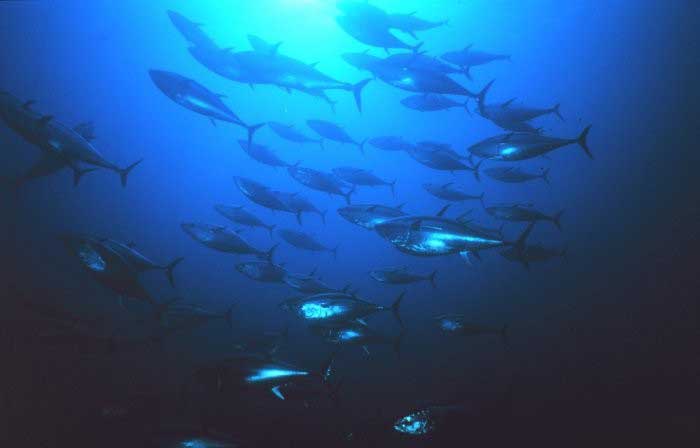 Ocean Fish
Ocean Fish
August 08, 2002
Topex/Poseidon is a little satellite that could. Launched on August 10, 1992, the joint U.S.- French spacecraft was designed to fly for three to five years. This week it celebrates its 10th anniversary and is still going strong.
When it turns 10, Topex/Poseidon will have made 46,763 trips around Earth measuring the height of the oceans to within 4 centimeters (less than 2 inches). Since launch, it will have faithfully provided more than 98 percent of the science data it was designed to collect despite technical and mechanical challenges, and its advancing years.
A successful mission is a combination of hardware, software and people. One key member of the Topex/Poseidon team is Parag Vaze, deputy manager for Earth sciences mission operations at JPL.
Vaze has been part of the Topex/Poseidon mission for longer than the satellite has been flying. He first came to JPL in 1992 while working for Fairchild, the company that built the satellite. "Someone was needed here for six months to deliver, commission and train personnel to use a flight system test bed just before the launch," he says. "That six month stint kept getting extended. I was able to offer some complementary skills to the operations team and eventually officially joined JPL in 1996," he says.
Vaze's job is to keep NASA's Earth-observing satellites operated by JPL flying and performing well. He heads the Earth science mission operations team under whose care are the venerable Topex/Poseidon and its follow-on, Jason 1, launched this past December. The team also provides support for Acrimsat, which measures the total amount of sunlight falling on Earth's atmosphere, oceans and land.
Q: You've been involved with Topex/Poseidon since 1990. What's the secret of its long life?
A: The original mission was designed for three years with a planned extension for up to five years. However, the design heritage for Topex/Poseidon--the bus and the architecture--is from a line of satellites that have had long lifetimes between five to 15 years. Two of Landsat series satellites, for example, have operated for more than 10 years.
Q: How many people are involved in flight operations for Topex/Poseidon?
A: At the beginning of the mission, there were 50 to 60 members of the flight team. Now, we have an integrated multi-mission team of about 15 to 20 people who support the mission operations.
Q: What have been some of the challenges?
A: Controlling attitude, the orientation of the satellite to Earth or the Sun, is a major issue for the satellite engineering team. Precise attitude control for Topex/Poseidon is critical in ensuring an accurate measurement of the sea-surface height.
Most elements of attitude control are performed automatically onboard with some maintenance and calibration functions done on the ground. Over the years, we've implemented software changes and found back door commands to make the satellite behave a little differently than originally designed to meet current flight conditions.
Topex/Poseidon has two star trackers--that's a device that senses the position of certain stars and helps the spacecraft maintain the correct attitude. One had a problem soon after launch and stopped working. Then after about 6 years, the second one stopped working. We had already developed a work-around, but miraculously, the first star tracker, the one that had latched up right after launch, started working again.
It was a very lucky event. The failed star tracker was stuck in a mode where some its operating logic was reversed. Only a coincidental set of events, including having a bright object pass by, occurring in the correct order would fix the problem. The moon swept through at just the right time, and the star tracker started working again.
Q: What's next for Topex/Poseidon now that its follow-on, Jason 1, was launched successfully?
A: Jason 1 moved into its operational orbit--just ahead of Topex/Poseidon on January 10th. Now that the cross-calibration is complete, Topex will move into a parallel orbit in effect doubling the amount of data that is now being collected.
This move, planned for August 15, is a challenge, and we have been studying it. We're concerned about the propulsion system. We haven't performed these types of maneuvers since launch. We've tested, calibrated and developed our plans along with contingency plans and we're confident that one way or the other, this will work.
Q: Has Topex/Poseidon been used for anything besides measuring sea-surface height?
A: We did use Topex/Poseidon as a demonstration platform for technology development of autonomous algorithms -- programs that allows a computer to "operate" by itself. One problem with new software and algorithms is that no one wants to use them if they haven't been used before.
We spent a year and a half developing and testing the software. Then, we changed all of Topex/Poseidon's flight software, planned and executed a maneuver. This new software basically performed a lot of the orbit maneuver design functions on-board instead of on the ground.
Q: What do you like best about your job?
A: "Mission operations" gives the impression that it is routine, but it isn't. I like to stay busy and stay abreast of new satellite designs and technology. This job is a good combination of technical challenges and management responsibility.
We've got a really good group, too, from upper management to the flight team. Everyone knows what's going on and takes pride in the mission.
Q: Ten years is a long time. What has changed for you personally in the past 10 years?
A: I have a new addition to my family. My daughter Sonia was born last September 20.
Contact: JPL/Rosemary Sullivant (818) 393-7490